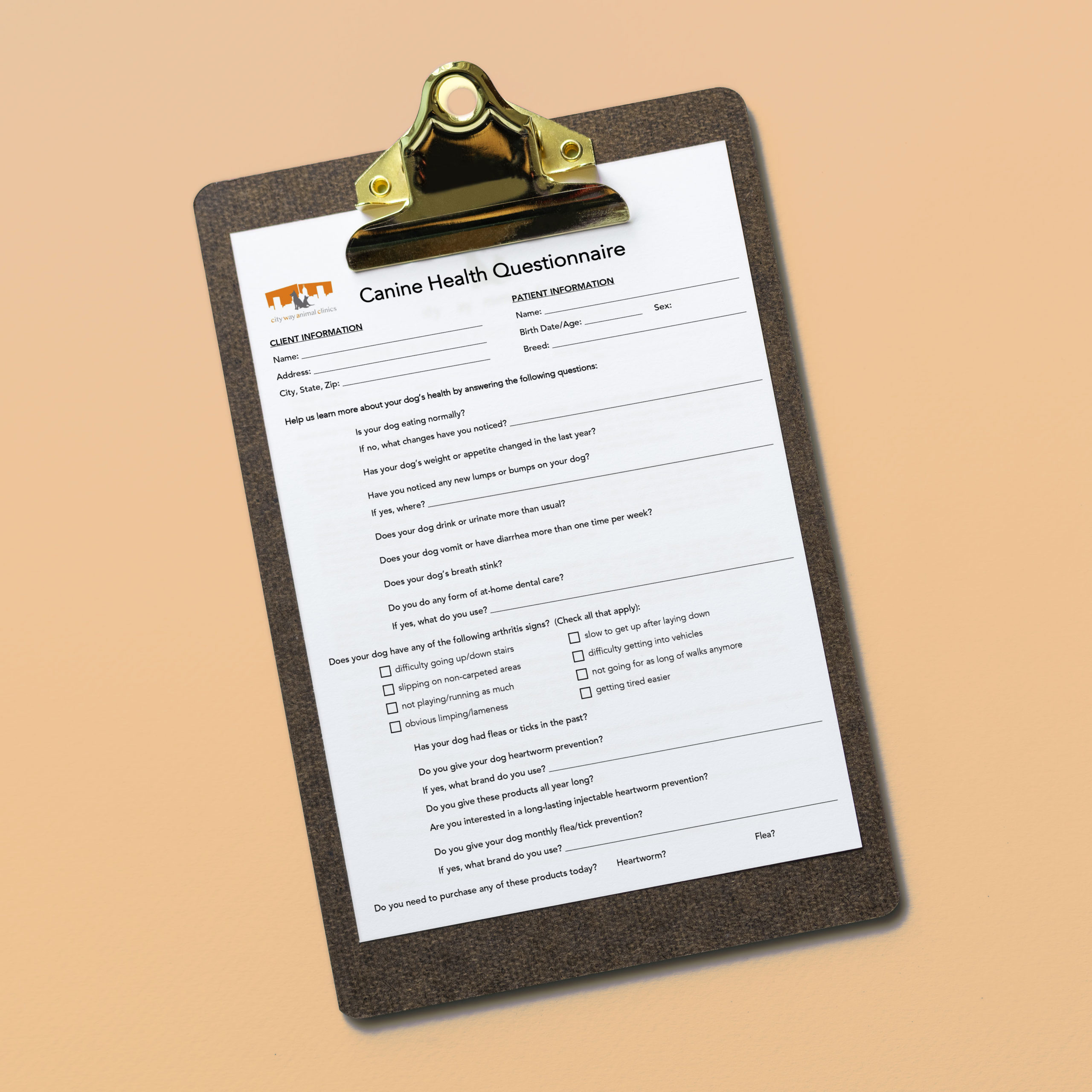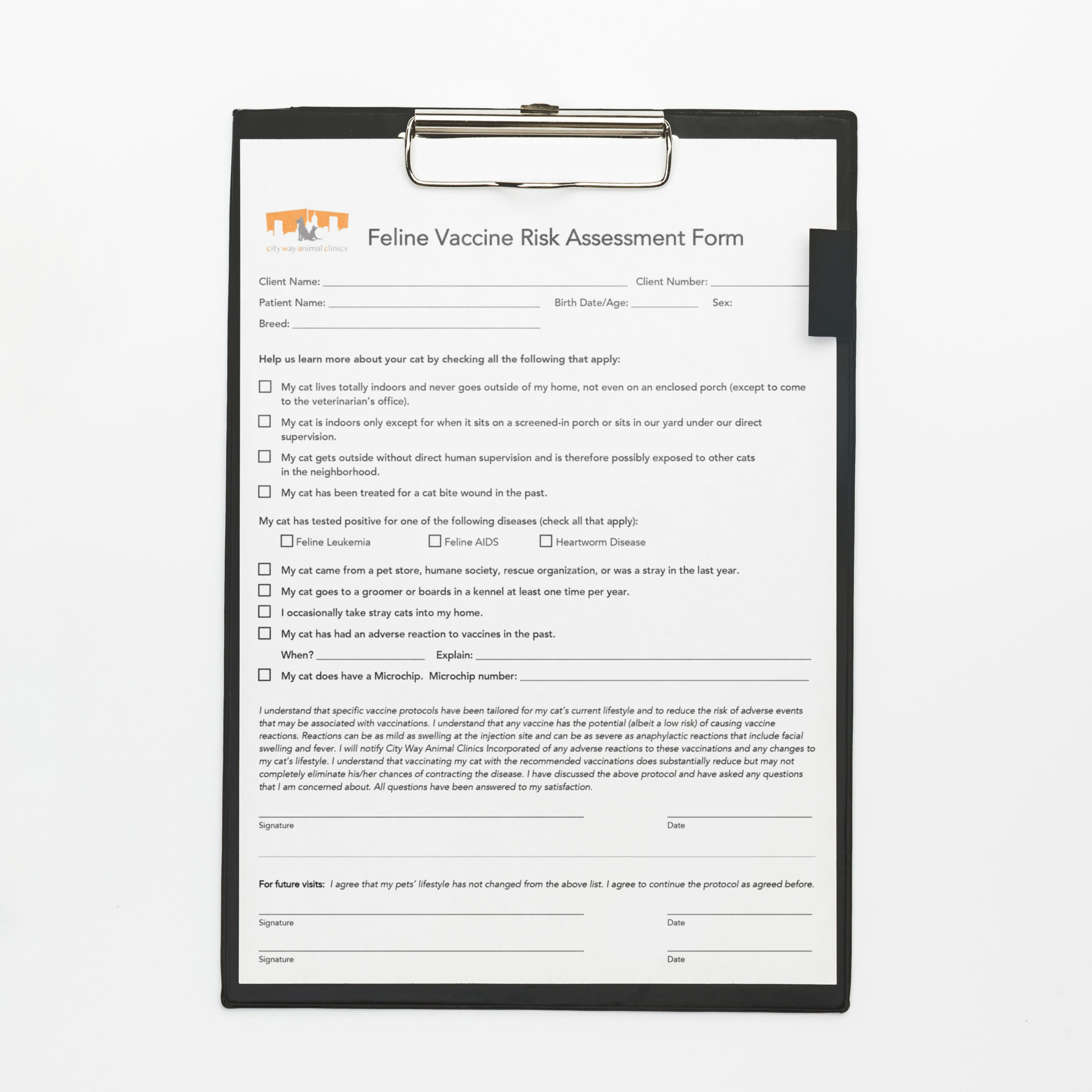
What to Expect at Your Yearly Vet Appointment
A thorough assessment is a critical first step in establishing your pet’s health status and can give you insight to your pet’s medical needs. That’s why we recommend all Cialis Best Price our patients be examined by a veterinarian every year. These physicals allow us to get to know your pet, assess their health, and detect any abnormalities or signs of disease.
Step 1 | Questions + Information Gathering
This process begins when you schedule an appointment at our clinic for the first time. Our Customer Service Representatives gather a complete description of your pet, including their species, breed, approximate age, sex, and reproductive status (ie. spayed, neutered, or intact). Certain diseases are more common among specific groups, like species, breeds, and age groups, so this is an important first step.
We ask all new clients to fill out a “New Client Form” so we have appropriate contact information and details about your pet(s).
We also request your pet’s medical records so we can add it to their file and our veterinary team can read through it before your appointment. Previous medical issues or diagnoses, vaccine history, heartworm or viral status, prior ownership, environmental and geographical factors, breeding history, diet, and current or past medications are all factors of your pet’s health.
Upon your appointment check-in or in an e-mail before your appointment, you’ll receive two documents to fill out: (1) a Canine or Feline Health Questionnaire and (2) a Canine or Feline Vaccine Risk Assessment Form.

Health Questionnaire
Filling out this document tells us whether or not your pet is eating and drinking normally, if you think they’ve experienced a weight change, if you’ve noticed any new lumps or bumps, and so on. We will ask about specific signs of arthritis, if you have an at-home dental care plan, or if your pets are on parasite prevention.
These questionnaires are species-specific in order to detect obvious disease signs. They also help us understand what your pet’s daily life is like, and how that may relate to their overall health.

Vaccine Risk Assessment Form
For dog owners, this form serves as an informational guide for our elective vaccinations, like Leptospirosis, Lyme Disease, Canine Cough (Bordetella), and Influenza.
For cat owners, this form helps us ascertain your cat’s risk to external factors. It will ask questions about how often your cat is outdoors or if they visit grooming facilities.
When it comes to vaccinating your pet, it’s easy to become overwhelmed with choices and information. These forms help us tailor our recommendations to your pet’s current lifestyle and health.
Once you fill out these documents, you’ll meet with a Veterinary Technician or Veterinary Assistant. Just like a nurse at your doctor’s office, the technician or assistant will enter the exam room to begin your pet’s appointment. They will:
- Continue to ask questions regarding your pet’s lifestyle and any symptoms they may have
- Help you decide which vaccines and parasite prevention are most fitting for your pet’s lifestyle
- Address any questions or concerns you have
- Collect any additional information the veterinarian will need for the appointment
Don’t be shy! All of our technicians and assistants are knowledgeable, well-trained, and here to help. They will record all of this information in the computer for your pet’s records and will speak to the veterinarian. Once the veterinary technician/assistant has briefed the veterinarian on your concerns and requested services, the veterinarian will begin a physical exam.
Step 2 | The Physical Exam
Every physical exam begins with some initial observations. Our veterinary team begins this part of the exam the moment they meet your pet, and can observe important details about your pet’s health just by looking at them.
Examples of Initial Observations
| anxiety + aggression (ex: drooling, shaking, growling, etc.) |
general appearance + body condition (ex: emaciation, obesity, proportion of body parts, etc.) |
| lumps, bumps, + swollen areas | obvious wounds or signs of disease |
| coat health + grooming habits (ex: well groomed, dirt or feces on coat, long nails, etc.) |
attitude + mental activity (ex: responsive + alert, dazed + disoriented, etc.) |
We make sure to record your pet’s vital signs in order to detect any abnormalities. This includes:
- weight
- temperature
- heartbeat
- breathing
Your veterinarian will then begin a hands-on systems exam. This portion of the physical gets its name from the nine main body systems your vet will examine. While it might look like we’re just petting or loving on your pet, we’re actually conducting a thorough examination. Believe it or not, an entire system exam only takes a few minutes!
| BODY SYSTEM | WHAT WE DO |
|---|---|
| The Cardiovascular System (heart, arteries, blood vessels, + blood) |
We listen to the heart for abnormalities like arrhythmias, murmurs, and muffled heart sounds. |
| The Gastrointestinal System (esophagus, stomach, intestines, + other internal organs) |
We check for symmetry in the body and feel the abdomen for masses, thickening of intestines, distension, and irregularities of organs. We apply minimal pressure to the kidneys and liver to detect any pain. |
| The Genitourinary System (ureters, urinary bladder, urethra, + genital organs) |
We examine the genitals, mammary regions, and rectal area for signs of disease, masses, herniation, polyps, infections, and more. We express anal glands when necessary and remove matting or feces around the genital or rectal area. |
| The Integumentary System (skin + coat) |
We note any hair loss, dermatitis, alopecia, fleas or ticks, mats, wounds, infections, redness, inflammation, abrasions, etc. |
| The Lymphatic System (lymph nodes + lymph vessels) |
We check for any enlargement or asymmetry that would signal changes in your pet’s immune system. |
| The Musculoskeletal System (muscles, bones, + joints) |
We look for muscle atrophy, deviations in the spine and signs of pain or arthritis. A pet’s gait, posture, and range of movement can indicate musculoskeletal or neurological diseases. |
| The Neurological System (brain, spinal cord, + nerves) |
We are aware of your pet’s response to stimuli in the room. Ataxia, incoordination, limping, proprioception deficits, head tilting, and drooping eyelids or lips are signs of neurological disease. |
| The Respiratory System (lungs + airways) |
We listen to your pet’s breathing for wheezing, crackling, coughing, or pitch changes. Their breathing should not be labored. |
| The Sensory System (ears, eyes, nose, + mouth) |
We check your pet’s ears and eyes for discharge, inflammation, parasites, and infection. We make sure their eyes dilate appropriately. We examine your pet’s mouth for masses, halitosis, loose teeth, plaque, and disease. |
Sometimes a pet is too anxious or aggressive for us to perform a hands-on exam. For their safety and ours, we can try placing a muzzle on the pet but sometimes that’s not enough. In these cases, the veterinary team may require partial or full sedation in order to perform a full exam.
Although this may sound scary, anxious pets who are at least partially sedated often have a more positive experience. Without sedation, their behavior can cause injuries to themselves and the people around them, and their behavior is likely to get worse at each vet visit.
Step 3 | Discussion + Plan
If your pet needs vaccines, a heartworm test, or other services, the veterinary technician/assistant will take your pet back to our treatment area for services. During this time, the veterinarian will talk to you about their observations and recommendations. Together, you will agree on a plan of action if your pet requires treatment for anything.
Your pet’s plan of action may include additional testing (like bloodwork, x-rays, urine testing, etc.) or medications. Once the technician/assistant comes back into the exam room with your pet, they will set up any future appointments.
Many people observe changes in their pet or realize they have additional questions after their appointment. That’s why we always call you after your pet’s appointment to address any questions or concerns you may have, as well as give any test results.
Biyearly appointments are recommended for senior pets or patients that require more frequent health assessments. Learn more about what kinds of things we recommend for pets seven years or older:
